


Compliance isn’t a pop quiz. The teacher—the U.S. Food and Drug Administration (FDA), in this case—has given you the answers to the test. Now, we’re not saying this open note test makes regulations like 21 CFR Part 820 easy to follow. But the challenge is different than you might first assume. What separates market leading medical device companies from the rest isn’t knowledge—it’s implementation.
Much, if not all, of the information is out there. The medical device companies that excel are the ones that can take it all in and execute—both in terms of understanding the big picture (What is 21 CFR Part 820? What does it cover? What is its purpose?) and the granular details (What goes into an approved supplier list?).
This in-depth, easy to understand guide paints a comprehensive picture of 21 CFR Part 820 by explaining the regulations in an easy to understand way. In addition to answering the aforementioned questions throughout this guide, each subpart of the regulation is accompanied by specific advice on how you can comply as well as common mistakes manufacturers face so you can make sure to avoid the pitfalls.
Let's get started by reviewing the basics of 21 CFR Part 820 before diving into the details of the regulatory requirements that you must follow in order to comply with FDA’s quality system regulation for medical devices.
FREE RESOURCE: Click here to download the eBook of our Ultimate Guide to 21 CFR Part 820.
 What is 21 CFR Part 820?
What is 21 CFR Part 820?21 CFR Part 820 is a set of regulations from FDA that outlines the current good manufacturing practice (CGMP) requirements that medical device manufacturers in the United States must follow with regards to their quality system. These CGMP requirements ensure medical device companies establish a QMS that enables the delivery of safe, effective, and compliant products.
As stated by FDA, 21 CFR Part 820 covers “the design, manufacture, packaging, labeling, storage, installation, and servicing of all finished devices intended for human use,” including the facilities and designs used for those processes.
21 CFR 820, though a dense document, lays out medical device quality system regulations (QSR) in a digestible way for manufacturers to best interpret and apply to their own specific device. The QSR consists of 15 subparts and is structured by way of order from big picture questions regarding scope to detailed rules about what manufacturers should do and when.
The very first section, Sec. 820.1 Scope, lays out the applicability, authority, and exemptions involved. It explains the intention of 21 CFR Part 820 (“to ensure that finished devices will be safe and effective”) and to whom it applies (“manufacturers of finished medical devices”). Important to this latter point, it notes that manufacturers that only engage in parts of the medical device manufacturing process only need to comply with relevant requirements.
This first section also establishes a rule that applies throughout the regulation: if a conflict between regulations emerges, “the regulation specifically applicable to the device in question shall supersede the more general.”
Section 820.3 provides definitions of 30 different terms used throughout 21 CFR Part 80.
These definitions, the first five of which are shown above, ensure manufacturers and regulators share a common understanding of the terminology in use. If you’re confused about the meaning of a term, refer to Section 820.3 or lean on trusted, outside resources, such as the Greenlight Guru list of the top medical device terminology.
21 CFR Part 820 has a close relationship with ISO 13485:2016, especially after the 2016 revision of ISO 13485, which closely aligns to the requirements found in FDA’s QSR. In February of 2022, FDA released its proposed rule to harmonize its QSR with ISO 13485:2016 for the new Quality Management System Regulation (QMSR).
The main difference between 21 CFR 820 and ISO 13485:2016 is that ISO 13485 is a voluntary standard that defines quality system requirements. 21 CFR Part 820 comes from FDA, a federal agency, meaning that noncompliance can incur punitive measures that range from citations to recalls to fines and, in rare cases, to litigation. While FDA is local to the United States, much of the world recognizes and follows ISO standards.
FDA conducts regular inspections to ensure compliance with 21 CFR 820. FDA uses the Quality System Inspection Technique (QSIT) to evaluate the alignment of internal quality system processes with regulatory requirements. The stakes of compliance are clear. Violations can result in 483 observations and warning letters.
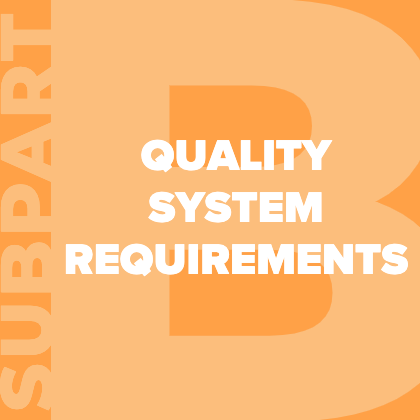
What it covers: 21 CFR Part 820 Subpart B covers management responsibility, internal quality audits, and personnel. This includes a range of roles, as well as what each role is in charge of doing and what training they require.
How to comply: §820.20, the first section of 21 CFR Part 820 Subpart B, covers management responsibility that includes regulations about policies, resources, and planning:
820.25, the third section of 21 CFR Part 820 Subpart B, covers Personnel. This section, as §820.20 mentions, lays out the requirements for manufacturers to have personnel who are experienced enough to ensure compliance. That includes providing training that covers potential defects these personnel might witness as a result of noncompliant activities.
Common mistake: Internal quality audits are often an area where manufacturers struggle. Many companies treat internal quality audits as a checkbox activity rather than a value-added activity, meaning they work toward mere compliance instead of quality outcomes.
There are two ways to make the shift from compliance-only to true quality:
The key to conducting successful internal quality audits is to take a proactive instead of a reactive approach.
 21 CFR Part 820 Subpart C—Design controls
21 CFR Part 820 Subpart C—Design controlsWhat it covers: 21 CFR Part 820 Subpart C covers design controls. Design controls are procedures that ensure devices are designed according to their requirements.
How to comply: 21 CFR Part 820 Subpart C first lays out which devices this section applies to. This includes Class I devices, such as devices automated with computer software, as well as the devices in the chart below.
21 CFR Part 820 Subpart C includes additional requirements during the design process:
Common mistake: Some companies wait too long to establish design controls, which can result in extra time and rework. The key is to establish your design controls early, so you can reliably capture all the data you need.
Design controls are what we call a systematic framework. Your company identifies and tracks which parts of the medical device manufacturing process prove your product meets user needs, demonstrates safety, and confirms effectiveness.
While some aspects of your QMS can be delayed, design controls cannot.
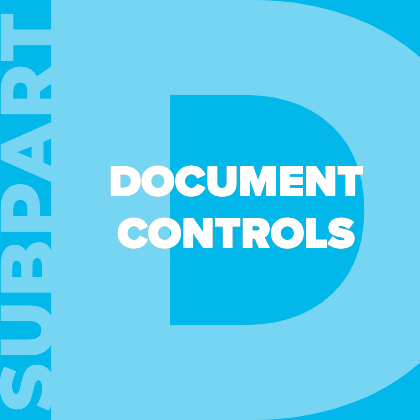 21 CFR Part 820 Subpart D—Document controls
21 CFR Part 820 Subpart D—Document controlsWhat it covers: 21 CFR Part 820 Subpart D covers document controls. Document control refers to policies and procedures quality managers use to manage documents throughout the medical device product lifecycle.
How to comply: 21 CFR Part 820 Subpart D lays out regulations for document approval and distribution as well as document changes:
Common mistake: Many companies err on the side of caution and over-document to a laborious extent. Instead, document what you need to demonstrate compliance. When documents become overly complex, they become unmanageable. When documents become unmanageable, compliance becomes difficult.
That said, too little documentation can expose a disconnect between the applicable regulations and your finished device. The best advice is to keep your document control simple. Be proactive and don’t wait to do documentation after the product is released.
 21 CFR Part 820 Subpart E—Purchasing Controls
21 CFR Part 820 Subpart E—Purchasing ControlsWhat it covers: 21 CFR Part 820 Subpart E covers purchasing controls. This includes the “evaluation of suppliers, contractors, and consultants,” as well as purchasing data.
How to comply: 21 CFR Part 820 Subpart E requires you to ensure compliance of the products and services you receive, specifically:
Common mistake: Many medical device companies aren’t as careful as they could be when selecting suppliers. 21 CFR Part 820 suggests manufacturers set out qualification requirements, but does not specify how stringent these should be, leaving many medical device companies with mediocre supplier management processes.
Truly effective supplier management means conducting due diligence audits of your suppliers, which can be done by sending out a supplier survey or by keeping an approved supplier list (ASL) to track which suppliers you’ve vetted and approved.
 21 CFR Part 820 Subpart F—Identification and Traceability
21 CFR Part 820 Subpart F—Identification and TraceabilityWhat it covers: 21 CFR Part 820 Subpart F covers identification and traceability. Identification refers to the ability to avoid product “mixups,” and traceability refers to the ability to trace product defects back to their source.
How to comply: 21 CFR Part 820 Subpart F includes only two short sections, the first of which is a single sentence long:
Common mistake: Original data from the 2020 State of Medical Device Report shows that traceability is hard to establish. Closed-loop traceability—when companies can connect post-market quality data and design activities—is rare among medical device companies.
Eight out of ten medical device companies struggle with documenting closed-loop traceability (CLT) in real time. The key is to leverage the best QMS software, a solution that replaces inefficient legacy systems that are inherently not capable of achieving CLT.
As the graph above shows, legacy tools make medical device companies significantly less confident in demonstrating traceability. Companies that invest in a modernized solution, like Greenlight Guru, can achieve closed-loop quality system traceability with ease. See your quality system like never before by getting a free demo of Greenlight Guru today.
 21 CFR Part 820 Subpart G—Production and Process Controls
21 CFR Part 820 Subpart G—Production and Process ControlsWhat it covers: 21 CFR Part 820 Subpart G covers Production and Process Controls. Controls include the inspection, measuring, and test equipment, as well as process validation.
How to comply: 21 CFR Part 820 Subpart G explains how you can control the device production process.
Subsection §820.72 hones in on details regarding the control of inspection, measuring, and test equipment:
Subsection §820.75 focuses on process validation:
Common mistake: Process validation is one of the most common areas prone to mistakes by companies when implementing 21 CFR Part 820. These requirements are found to be most challenging for companies that try to validate their processes from scratch and, in so doing, struggle to correctly interpret the regulation.
The goal of process validation is to demonstrate that you can replicate your processes. Each time you run a validated process, you expect the same level of quality every time.
Ensuring this level of replicability is hard to do from scratch using ad hoc systems. With a modern QMS from Greenlight Guru, however, you can use pre-validated components. These components include templates and workflows that have weathered a multitude of audits.
 21 CFR Part 820 Subpart H—Acceptance Activities
21 CFR Part 820 Subpart H—Acceptance ActivitiesWhat it covers: 21 CFR Part 820 Subpart H covers acceptance activities. This includes receiving, in-process, and finished device acceptance as well as regulations for acceptance status.
How to comply: 21 CFR Part 820 Subpart H explains how you can properly accept incoming products:
Subsection §820.86 digs into the definition of acceptance status. Acceptance status indicates whether a product conforms with pre-established criteria. FDA emphasizes the ability of the manufacturer to identify acceptance “throughout manufacturing, packaging, labeling, installation, and servicing of the product.”
Common mistake: If your inspection doesn’t have a structure to it, it will be difficult to ensure its effectiveness. Including criteria, so you’re not inspecting ad hoc, will help manufacturers avoid this common mistake. You always need to confirm that your specifications and acceptance criteria have been met.
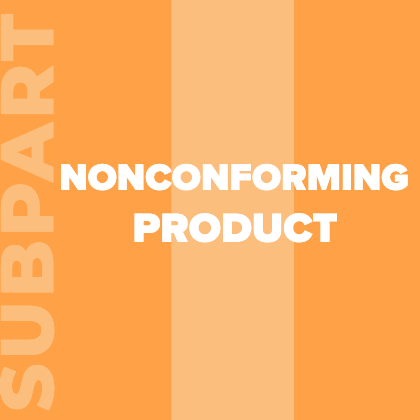 21 CFR Part 820 Subpart I—Nonconforming Product
21 CFR Part 820 Subpart I—Nonconforming ProductWhat it covers: 21 CFR Part 820 Subpart I covers nonconforming product. This includes control of nonconforming product as well as review, disposition, and rework.
How to comply: 21 CFR Part 820 Subpart I requires manufacturers to keep close control over products that don’t conform to requirements:
Common mistake: A recurring compliance issue that plagues manufacturers with 483 notifications are inadequate procedures for controlling nonconforming product. Make sure you can identify nonconforming product and keep it segregated from conforming product.
After dealing with nonconforming product, companies often forget to document the nonconformance process correctly. Download this free nonconformance template to help you streamline the reporting process. With the right documentation, you can better assess when you’ll need to investigate more deeply.
 21 CFR Part 820 Subpart J—Corrective and Preventive Action (CAPA)
21 CFR Part 820 Subpart J—Corrective and Preventive Action (CAPA)What it covers: 21 CFR Part 820 Subpart J covers corrective and preventive action, better known as CAPA. CAPA is the process whereby medical device companies address systemic flaws in the medical device manufacturing process.
How to comply: According to FDA, compliant CAPA procedures must:
Common mistake: Not all product defects should cause CAPA. Isolated incidents can be dealt with through minor corrections. You can ensure you’re following best practices for CAPA by downloading this free CAPA template.
A modern QMS can get you out of a reactive pose and into a proactive one. Greenlight Guru, which is equipped with CAPA management software, automates CAPA workflows to make it easier for companies to identify and address systemic quality issues.
 21 CFR Part 820 Subpart K—Labeling and Packaging Control
21 CFR Part 820 Subpart K—Labeling and Packaging ControlWhat it covers: 21 CFR Part 820 Subpart K covers labeling and packaging control. This includes label integrity, inspection, storage, and operations.
How to comply: 21 CFR Part 820 Subpart K contains two subsections: one specific to device labeling and the other covering device packaging. Subsection §820.120 requires manufacturers to control these labeling activities:
Subsection §820.130 is a short subsection that focuses on device packaging. It requires the packaging and shipment of devices in a way that protects products from alteration or damage during “processing, storage, handling, and distribution.”
Common mistake: Applying blanket rules on device labeling. Avoid this mistake by looking to FDA precedent and see what specific labeling needs your particular device will require.
FDA writes at length about key considerations when labeling sterilized devices: label what is and what is not sterile in a package, provide directions for sterilization if it’s not pre-sterilized, offer instructions on how to open the package so that the contents remain sterile, and more.
The exact importance of labeling varies depending on the device. If you’re producing sterilized devices, for example, labeling is extremely important.
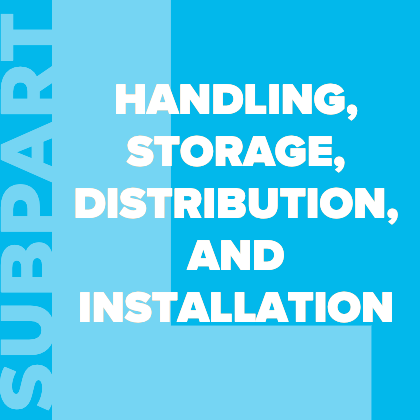 21 CFR Part 820 Subpart L—Handling, Storage, Distribution, and Installation
21 CFR Part 820 Subpart L—Handling, Storage, Distribution, and InstallationWhat it covers: 21 CFR Part 820 Subpart L covers handling, storage, distribution, and installation. This includes stipulations for compliant processes for storing and distributing products.
How to comply: 21 CFR Part 820 Subpart is split, as the subtitle implies, into four sections.
The first subsection, §820.140, focuses on handling and requires you to have procedures that prevent “mixups, damage, deterioration, contamination, or other adverse effects” during handling.
The second subsection, §820.150, focuses on storage:
The third subsection, §820.160, focuses on distribution:
The fourth subsection, §820.170, focuses on installation:
Common mistake: Many medical device companies don’t define all the handling procedures that should be defined. If your product requires installation at point of use, for instance, then you also need to define that. That includes defining installation requirements and specifications. All of this must be clearly documented.
These definitions should also come with acceptance criteria to help users verify the correct installation. You’ll identify this criteria when defining user needs during design and development.
 21 CFR Part 820 Subpart M—Records
21 CFR Part 820 Subpart M—RecordsWhat it covers: 21 CFR Part 820 Subpart M covers records. This includes a set of general requirements, regulations for the quality system record and complaint files, as well as the oft-confused device master record and device history record.
How to comply: 21 CFR Part 820 Subpart M is one of the more complex sections of 21 CFR Part 820 and contains five subsections.
Subsection §820.180 lays out general requirements:
Subsection §820.181 explains the requirements for the device master record (DMR). Manufacturers must maintain a DMR that includes:
Subsection §820.184 explains the requirements for the device history record (DHR). Manufacturers must maintain a DHR that includes:
Subsection §820.186 explains the requirements for a quality system record (QSR). Your QSR must include everything required in this part of 21 CFR Part 820, including §820.20.
Subsection §820.198 focuses on the requirements for complaint files:
Download our free complaint template that’s designed to help you streamline the complaint process.
Common mistake: : Some companies log everything as “product issues” when, in fact, many of them should be logged as complaints. One company logged over 500 product issues, but many of these issues mentioned problems, like melting, burning, and smoking, that went beyond issues. These are complaints—not issues.
This lack of proper logging increases the likelihood that a company will receive a warning letter. You can reduce the chance of these citations by using a quality management solution with purpose-built complaint management workflows that flag high risk situations.
 21 CFR Part 820 Subpart N—Servicing
21 CFR Part 820 Subpart N—ServicingWhat it covers: 21 CFR Part 820 Subpart N covers servicing.
How to comply: Not every device requires servicing but those that do need to comply with this section:
Common mistake: Some medical device companies lay out instructions for servicing but don’t do enough to verify the device meets specifications after said servicing. To ensure specifications are met, define your servicing requirements, specifications, and procedures. Maintain records to confirm that servicing was done correctly, and was in fact verified as effective.
Even if you outsource servicing to suppliers, these requirements hold true. Qualify, evaluate, and monitor the servicing suppliers you use and list them on your approved supplier list (ASL).
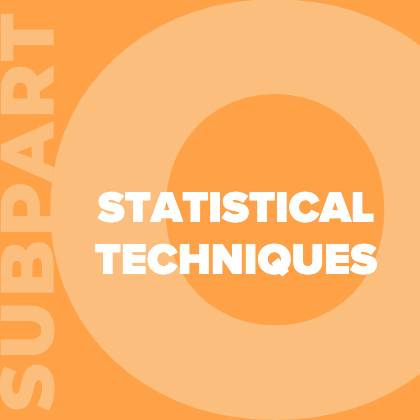 21 CFR Part 820 Subpart O—Statistical Techniques
21 CFR Part 820 Subpart O—Statistical TechniquesWhat it covers: 21 CFR Part 820 Subpart O covers statistical techniques. Compliant statistical techniques are intended to help manufacturers establish, control, and verify the “acceptability of process capability and product characteristics.”
How to comply: Statistical techniques are a core part of the service reports in 21 CFR Part 820 Subpart N and receive their own set of requirements for:
Common mistake: FDA leaves the scope of statistical techniques up to the medical device establishment. Keep abreast of innovative statistical techniques to give your company a leg up for performing clinical trials and making benefit-risk decisions.

 Simplify 21 CFR Part 820 Compliance with a Medical Device QMS Solution
Simplify 21 CFR Part 820 Compliance with a Medical Device QMS SolutionFollowing the FDA quality system regulations outlined in 21 CFR Part 820 can be a simple or challenging task depending on the type of QMS solution used by the manufacturer.
Legacy and ad hoc systems create burdensome hoops that teams must jump through to satisfy compliance requirements, contributing in many of the common mistakes mentioned throughout this guide.
Modern QMS solutions help manufacturers do their jobs better while eliminating work. No more fiddling with your QMS to ensure it aligns with regulations: Greenlight Guru’s QMS aligns with the latest industry regulations and standards, including 21 CFR Part 820 and 21 CFR Part 11, ISO 13485, and ISO 14971. It is the only industry-specific QMS software that allows medical device companies to achieve total lifecycle traceability within a closed-loop quality system.
With Greenlight Guru, you can finally move beyond baseline compliance and achieve True Quality outcomes for your quality system and the medical device it’s meant to support. Get your free demo of our QMS software today.
Etienne Nichols is a Medical Device Guru and Mechanical Engineer who loves learning and teaching how systems work together. He has both manufacturing and product development experience, even aiding in the development of combination drug-delivery devices, from startup to Fortune 500 companies and holds a Project.